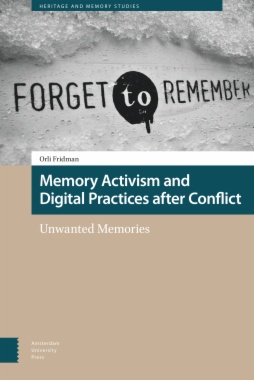This book investigates the study of memory activism and memory of activism, emerging after conflict, as a political civic action. It examines the appearance and growth of memory activism in Serbia amid the legacies of unwanted memories of the wars of the 1990s, approaching the post-Yugoslav region as a region of memory and tracing the alternative calendars and alternative commemorative practices of memory activists as they have evolved over a period of more than two decades. By presenting in-depth accounts of memory activism practices, on-site and online, Memory Activism and Digital Practices after Conflict: Unwanted Memories analyses this evolution in the context of generational belonging and introduces frameworks for the study of #hashtag #memoryactivism, alternative commemorations and commemorative solidarity.
- Cover
- Table of Contents
- Preface
- Acknowledgements
- Introduction
- Memory Activism and Alternative Commemorative Practices after Conflict
- Memory activism and memory of activism after conflict
- Agentic activism: a positive turn in memory studies, a local turn in peace and conflict studies
- Non-state commemorations: alternative commemorative events after conflict
- Generational belonging in memory activism
- Outline of the book
- Bibliography
- 1. Unwanted Memories of (the Wars of) the 1990s
- Referencing the 1990s
- The recent past is still present
- Memory politics and public knowledge of the wars of the 1990s
- The 1990s in the state calendar and state-sponsored commemorations
- Memory activism after conflict: remembering the wars of the 1990s in Serbia
- Bibliography
- 2. ‘Not in My Name’
- From Anti-War to Memory Activism: The First Generation
- Memory activism as an extension of anti-war activism and the emergence of an alternative civic calendar
- Commemorating Srebrenica in Belgrade: 10 July on the alternative calendar
- Generational commemorative legacy
- Bibliography
- 3. ‘Too Young to Remember, Determined Never to Forget’
- The Second Generation
- A new generation, a new slogan
- Continuity and change in the commemoration of Srebrenica in Belgrade
- The burden of a silenced past: remembering the Suva Reka massacre and mass graves in Batajnica
- Beyond annual commemorations: remembering Batajnica through alternative education and art
- The Batajnica Memorial Initiative
- Memory walks: marking and visiting sites of suppressed memory
- Memory activism as protest: opposing the public glorification of war crimes
- Bibliography
- 4. Hashtag Memory Activism
- Digital Memory Practices and Online Commemorations
- #Hashtag #memoryactivism
- #Sedamhiljada: from a hashtag to a banned commemoration
- #NisuNašiHeroji: generational mnemonic claims and the post-Yugoslav space as a region of memory
- #JesteSeDesilo: disseminating knowledge as an act of silence breaking
- #WhiteArmbandDay: from local to regional and transnational memory activism
- Bibliography
- 5. Regions of Memory
- The Post-Yugoslav Space as a Region of Memory Activism
- Regions of memory and of memory activism
- Regional cooperation as a ‘crowded playground’
- Regional networks of joint action and joint claims
- Remembering Yugoslavia and the anti-fascist struggle
- Regional platforms for engagement with memories of the wars of the 1990s
- Commemorative solidarity and the wars of the 1990s
- Bibliography
- Epilogue
- Unwanted Pasts in an Unresolved Present
- Bibliography
- Appendices
- Appendix 1 YIHR Transitional Justice Calendar
- Appendix 2 March 2010 YIHR Announcement of ‘Action to commemorate crimes committed in Kosovo in March and April 1999’
- Appendix 3 CPI Brochure: ‘Program of guided tours to places of “Suppressed memories”’
- Appendix 4 Women’s Court Invitation to Hear Public Testimonies in Sarajevo, May 2015
- Bibliography
- Index
- List of Figures
- Figure 1 The divided Republic Square, 10 July 2009
- Figure 2 The Women in Black-led commemoration on Republic Square on10 July (left); the commemoration in front of the National Assembly on11 July (right)
- Figure 3 The Suva Reka commemoration on 26 March 2016
- Figure 4 The street action on 26 March 2019 in Belgrade
- Figure 5 Tweets by Dušan Mašić on 17 April 2015 (left), and on 18 April 2015 (right)with the hashtag #sedamhiljada
- Figure 6 Graffiti that appeared in Belgrade after the #sedamhiljadacommemorative event was banned
- Figure 7 The logo designed by Mirko Ilić for the #sedamhiljada campaign
- Figure 8 Twitter post by YIHR Serbia, 10 December 2017
- Figure 9 Image posted on the YIHR Facebook page, showing the #JesteSeDesilohashtag, with text announcing the launch of the War in Serbia website,1 June 2020
- Figure 10 A Twitter post marking the 31 May 2017 online #WhiteArmbandDaycommemoration
- Figure 11 A Twitter post sharing images of the 31 May 2017 onsite commemorationof White Armband Day in Prijedor, Bosnia and Herzegovina, using the
- Figure 12 Drawing by Midhat Kapetanović of Vučko, Zagi, and the Pobednik (leftto right), posted on Instagram on 11 July 2020

